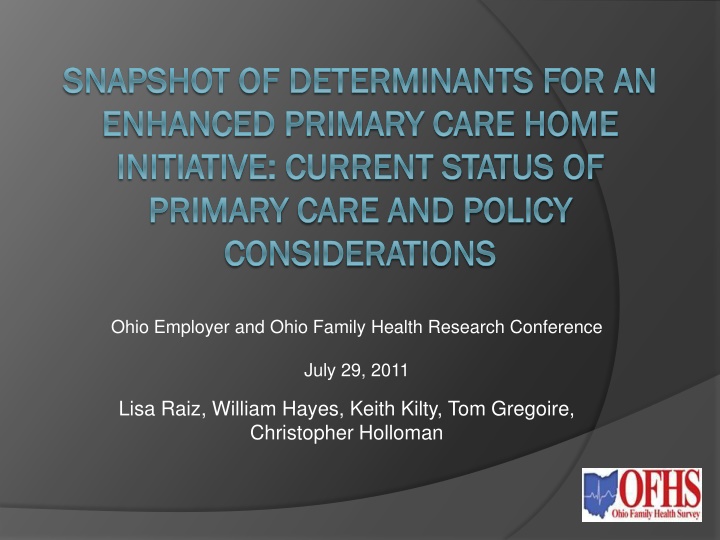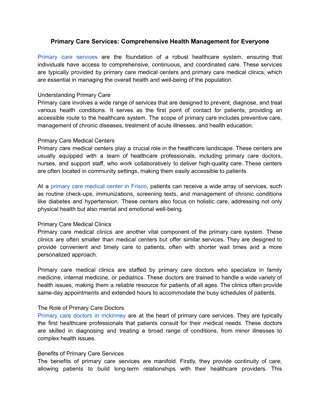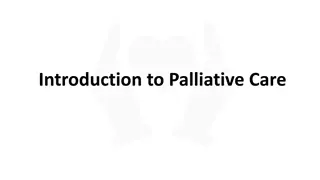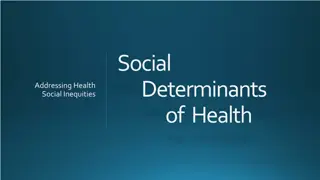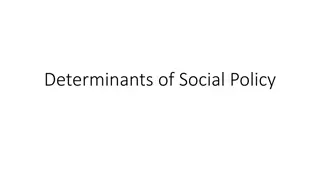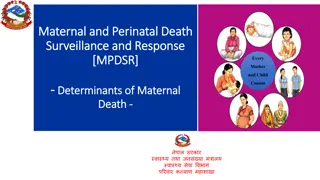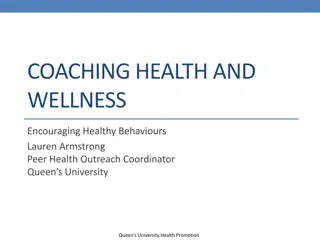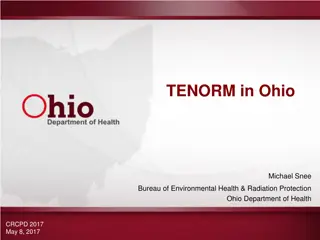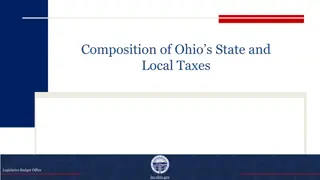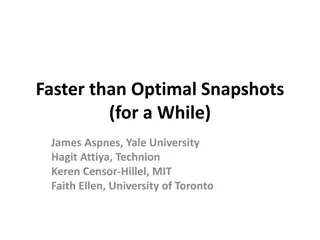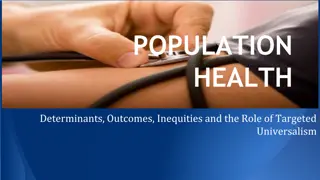Enhancing Primary Care in Ohio: Snapshot of Determinants & Policy Considerations
This project delves into the determinants affecting primary care access in Ohio, aiming to estimate the population's primary care status, influence on health outcomes, and policy implications. Key areas covered include defining primary care, levels of care use, sociodemographic variables, and a logic model to understand care utilization patterns and health outcomes.
Download Presentation

Please find below an Image/Link to download the presentation.
The content on the website is provided AS IS for your information and personal use only. It may not be sold, licensed, or shared on other websites without obtaining consent from the author.If you encounter any issues during the download, it is possible that the publisher has removed the file from their server.
You are allowed to download the files provided on this website for personal or commercial use, subject to the condition that they are used lawfully. All files are the property of their respective owners.
The content on the website is provided AS IS for your information and personal use only. It may not be sold, licensed, or shared on other websites without obtaining consent from the author.
E N D
Presentation Transcript
SNAPSHOT OF DETERMINANTS FOR AN SNAPSHOT OF DETERMINANTS FOR AN ENHANCED PRIMARY CARE HOME ENHANCED PRIMARY CARE HOME INITIATIVE: CURRENT STATUS OF INITIATIVE: CURRENT STATUS OF PRIMARY PRIMARY C CARE AND POLICY ARE AND POLICY CONSIDERATIONS CONSIDERATIONS Ohio Employer and Ohio Family Health Research Conference July 29, 2011 Lisa Raiz, William Hayes, Keith Kilty, Tom Gregoire, Christopher Holloman
Agenda Project Aims Defining Primary Care Expanded Focus Aim 1 Aim 2 Policy Considerations Next Steps
Project Aims 1. To estimate the proportion of Ohioans who have, or do not have, primary care 2. To examine the association between having, or not having, primary care and unmet health needs, health status and health outcomes 3. To develop an operational definition of Enhanced Primary care Home specific to Ohio policy, rules and laws
Defining Primary Care Usual source of care yes/no 1. a. Place care is received Clinic or health center Doctor s office or HMO Hospital emergency room Other 2. a. b. c. d. Levels of care use Enhanced use Limited use No use 3. a. b. c.
Three Levels of Primary Care Use 1. Enhanced use Received a routine check-up during previous year 2. Limited use No routine check-up; visited a doctor during previous year 3. No use No routine check up; did not visit a doctor during previous year
Sociodemographic Variables SES Age 18-24 25-34 35-44 45-54 55-64 <100%FPL 101-138%FPL 139-150%FPL 151-200%FPL 201-250%FPL >300%FPL Region Appalachia Chronic Conditions Not chronic Chronic mental health Other chronic Rural, non-Appalachia Suburban Metropolitan Insurance Medicare Medicaid Dual eligibles Private ESI Other private Uninsured Race/Ethnicity Asian Black Hispanic White Sex Female Male
Logic Model 3 2 No use (not see doctor in last year and no checkup) 1 Outcomes related to health care utilization or health events, such as unmet need, BMI smoking status, alcohol use access to specialist hospital visits stable with diabetes ER visits care coordination need Physician Limited use (saw doctor in last year, no checkup) Yes Enhanced use (had checkup in last year) Clinic No use (not see doctor in last year and no checkup) Population of interest Usual Source of Care Limited use (saw doctor in last year, no checkup) ER Enhanced use (had checkup in last year) Compare populations by income, region, insurance type, age, race/ethnicity, sex Insured/uninsured has 6 categories: ESI, other private, Medicaid, Medicare, dual eligible, and uninsured No Other site
Expanded Focus INDIVIDUALS WITH CHRONIC CONDITIONS
Patient Protection and Affordable Care Act Title II: Role of Public Programs Subtitle I: Improving the Quality of Medicaid for Patients and Providers Section 2703: State Option to Provide Health Homes for Enrollees with Chronic Conditions Eligible individuals: Eligible for State assistance Has at least: - 2 chronic conditions - 1 chronic condition and is at risk of having a second chronic condition; or - 1 serious and persistent metal health condition
Chronic Conditions Populations with chronic conditions Not chronic Chronic mental health Other chronic Risk Factors: Currently smokes cigarettes Positive response to any episodes of binge drinking
Chronic Groups Group Variable Chronic Groups Total 0-100%FPL 101-138%FPL 2008 Not chronic Chronic mental health Other chronic 71.3% 6.4% 22.3% 62.0% 14.0% 24.0% 67.4% 9.3% 23.3% 2010 Not chronic Chronic mental health Other chronic 71.4% 8.2% 20.4% 63.1% 14.2% 22.7% 67.3% 12.0% 20.7%
Aim 1 What is the proportion of Ohioans who have primary care? What is the proportion of Ohioans who have primary care, based on sociodemographic variables? What variables are associated with an increased likelihood of having primary care?
Usual Source of Care: Chronic Conditions 100 90 80 70 % with a usual source of care 60 2008 - Yes 2008 - No 2010 - Yes 2010 - No 50 40 30 20 10 0 All Not chronic Chronic mental health Other chronic
Usual Source of Care: Insurance Type 100 90 80 70 % with a usual source of care 60 50 2008 - Yes 2008 - No 2010 - Yes 2010 - No 40 30 20 10 0
Usual Source of Care: Region of Residence 100 90 80 70 % with a usual source of care 60 50 40 2008 - Yes 2008 - No 2010 - Yes 2010 - No 30 20 10 0
Usual Source of Care: Age 100 90 80 70 % with a usual source of care 60 2008 - Yes 2008 - No 2010 - Yes 2010 - No 50 40 30 20 10 0 All Age 18- 24 Age 25- 34 Age 35- 44 Age 45- 54 Age 55- 64
Usual Source of Care: Race and Ethnicity 100 90 80 % with a usual source of care 70 60 2008 - Yes 2008 - No 2010 - Yes 2010 - No 50 40 30 20 10 0 All White Black Asian Hispanic
Usual Source of Care: Socioeconomic Status 100 90 80 70 % with a usual source of care 60 50 2008 - Yes 2008 - No 2010 - Yes 2010 - No 40 30 20 10 0
Place Care is Received 11 response categories (if usual source of care) Clinic or health center Doctor s office or HMO Hospital emergency room Hospital outpatient department Military hospitals Does not go to one place most often Books/internet/hotline Hospital Urgent care Family member or friend Some other place
Place Care is Received - 2008 Doctor s Office or HMO: 73.6% all Ohioans >73.6% 60%-73.5% 50-59.9% 40-49.9% Medicaid Dual eligible Chronic mental health 18-24 <100%FPL Other private Other chronic Appalachia Metro 25-34 Asian Male 101-138%FPL 139-150%FPL 151-200%FPL Uninsured Black Hispanic Medicare Private ESI Not chronic Rural Non App Suburban 35-44 45-54 55-64 White Female 201-250%FPL 251-300%FPL >300%FPL
Place Care is Received - 2010 Doctor s Office or HMO: 72.5% all Ohioans >72.5% 60%-72.4% 50-59.9% 40-49.9% Medicaid Dual eligible Chronic mental health 18-24 Asian Hispanic <100%FPL Other chronic Appalachia Metro 25-34 35-44 Male 101-138%FPL 139-150%FPL 151-200%FPL Uninsured Black Medicare Private ESI Other private Not chronic Rural Non App Suburban 45-54 55-64 White Female 201-250%FPL 251-300%FPL >300%FPL Increased by >4% Decreased by >4%
Place Care is Received - 2008 Clinic: 13.1% all Ohioans >20% 13.2-19.9% <13.1% Medicare Private ESI Not chronic Rural non-App Suburban 35-44 45-54 55-64 White Female 251-300%FPL >300%FPL Medicaid Dual eligible Uninsured Chronic mental health Black Asian Hispanic (>30%) <100%FPL Other private Other chronic Appalachia Metro 18-24 25-34 Male 101-138%FPL 139-150%FPL 151-200%FPL 201-250%FPL
Place Care is Received - 2010 Clinic: 14% all Ohioans >20% 14.1-19.9% <14% Medicare Private ESI Not chronic Rural non-App Suburban 35-44 55-64 White Female 201-250%FPL 251-300%FPL >300%FPL Medicaid Uninsured Chronic mental health Black Hispanic (>30%) <100%FPL Dual eligible Other private Other chronic Appalachia Metro 18-24 25-34 45-54 Asian Male 101-138%FPL 139-150%FPL 151-200%FPL Increased by >4% Decreased by >4%
Place Care is Received - 2008 Emergency Room: 5.8% all Ohioans <5.8% >15% 10-14.9% 5.8-9.9% Dual eligible Chronic mental health 18-24 Black 101-138%FPL Medicaid Uninsured <100%FPL Other chronic Appalachia Metro 25-34 35-44 Hispanic Male 139-150%FPL 151-200%FPL Medicare Private ESI Other private Not chronic Rural Non App Suburban 45-54 55-64 White Asian Female 201-250%FPL 251-300%FPL >300%FPL
Place Care is Received - 2010 Emergency Room: 5.2% all Ohioans <5.2% >15% 10-14.9% 5.2-9.9% Medicaid Dual eligible Black <100%FPL 139-150%FPL Uninsured Other chronic Chronic mental health Metro 18-24 25-34 35-44 Hispanic Male 101-138%FPL Medicare Private ESI Other private Not chronic Appalachia Rural Non App Suburban 45-54 55-64 White Female 151-200%FPL 201-250%FPL 251-300%FPL >300%FPL Increased by >4% Decreased by >4%
Place Care is Received: Chronic Conditions - 2008 100 90 80 % with place for care 70 60 Clinic Doctor ER Other 50 40 30 20 10 0 All Not chronic Chronic mental health Other chronic % with
Place Care is Received: Insurance Type - 2008 100 90 80 % with place for care 70 60 50 Clinic Doctor ER Other 40 30 20 10 0
Place Care is Received: Insurance Type - 2010 100 90 80 % with place for care 70 60 50 Clinic Doctor ER Other 40 30 20 10 0
Place Care is Received: Region of Residence - 2008 100 90 80 70 % with place for care 60 50 40 Clinic Doctor ER Other 30 20 10 0
Place Care is Received: Region of Residence - 2010 100 90 80 70 % with place for care 60 50 40 30 Clinic Doctor ER Other 20 10 0
Place Care is Received: Race and Ethnicity - 2008 100 90 80 % with place for care 70 60 Clinic Doctor ER Other 50 40 30 20 10 0 All White Black Asian Hispanic
Place Care is Received: Race and Ethnicity - 2010 100 90 80 70 % with place for care 60 Clinic Doctor ER Other 50 40 30 20 10 0 All White Black Asian Hispanic
Place Care is Received: Socioeconomic Status - 2008 100 90 80 % with place for care 70 60 50 Clinic Doctor ER Other 40 30 20 10 0
Place Care is Received: Socioeconomic Status - 2010 100 90 80 % with place for care 70 60 50 Clinic Doctor ER Other 40 30 20 10 0
Logic Model 3 2 No use (not see doctor in last year and no checkup) 12.8 1 Outcomes related to health care utilization or health events, such as unmet need, BMI smoking status, alcohol use access to specialist hospital visits stable with diabetes ER visits care coordination need Physician 73.6% Limited use (saw doctor in last year, no checkup) 25.3% Yes 91.1% Enhanced use (had checkup in last year) 62% Clinic No use (not see doctor in last year and no checkup) 17.1% All age 18 and over Ohioans 2008 13.1% Usual Source of Care Limited use (saw doctor in last year, no checkup) 24.3% Emergency Room 5.8% Enhanced use (had checkup in last year) 58.6% Compare populations by income, region, insurance type, age, race/ethnicity, sex Insured/uninsured has 6 categories: ESI, other private, Medicaid, Medicare, dual eligible, and uninsured No 8.1% Other site 7.5%
Logic Model 3 2 No use (not see doctor in last year and no checkup) 8% 1 Outcomes related to health care utilization or health events, such as unmet need, BMI smoking status, alcohol use access to specialist hospital visits stable with diabetes ER visits care coordination need Physician Limited use (saw doctor in last year, no checkup) 24.8% 50.8% Yes 90.1% Enhanced use (had checkup in last year) 67.2% Clinic No use (not see doctor in last year and no checkup) 12.4% Medicaid 2008 23% Usual Source of Care Limited use (saw doctor in last year, no checkup) 23% Emergency Room 15.2% Enhanced use (had checkup in last year) 64.7% Compare populations by income, region, insurance type, age, race/ethnicity, sex Insured/uninsured has 6 categories: ESI, other private, Medicaid, Medicare, dual eligible, and uninsured No 8.0% Other site 11.1%
Logic Model 3 2 No use (not see doctor in last year and no checkup) 3.2% 1 Outcomes related to health care utilization or health events, such as unmet need, BMI smoking status, alcohol use access to specialist hospital visits stable with diabetes ER visits care coordination need Physician Limited use (saw doctor in last year, no checkup) 32.6% 58.3% Yes 93.4% Enhanced use (had checkup in last year) 64.3% Clinic No use (not see doctor in last year and no checkup) 11% Chronic mental health 2008 20.4% Usual Source of Care Limited use (saw doctor in last year, no checkup) 27.8% Emergency Room 11.1% Enhanced use (had checkup in last year) 61.2% Compare populations by income, region, insurance type, age, race/ethnicity, sex Insured/uninsured has 6 categories: ESI, other private, Medicaid, Medicare, dual eligible, and uninsured No 6.2% Other site 10.2%
Aim 2 What is the relationship between having primary care and ER use? What is the relationship between having primary care and access to care from a specialist? What is the relationship between having primary care and health status? What is the relationship between having primary care and health outcomes?
Aim 2 ER use: number of ER visits Access to a specialist: degree of difficulty seeing a specialist Health status: general health Health outcomes: number of hospitalizations; BMI; smoking status, Diabetes control Unmet needs: not filled a prescription due to cost; not get other health care needed, frequency of getting needed help coordinating care Rating of health care
Having a Usual Source of Care is associated with: More ER visits * Hospital admissions * Control of diabetes * Satisfaction with health care * Less Difficulty seeing a specialist *+ Worse general health* Likely to smoke + Likely to report not getting other needed care
Outcomes by Place Care is Received Clinic v. ER Clinic v. Doctor ER v. Doctor ER Visits 2008 more more more 2010 more ns more Hospital admissions 2008 more ns more Difficulty seeing a specialist 2008 more more more 2010 more ns more
Unmet Needs by Place Care is Received Clinic v. ER Clinic v. Doctor ER v. Doctor Not filled a prescription due to cost 2008 more ns more 2010 more ns more Not get other health care needed 2008 more ns more 2010 ns ns more
Select Variables by Place Care is Received Clinic v. ER Clinic v. Doctor ER v. Doctor General Health 2008 ns better better 2010 ns ns better Health care rating 2008 better better better 2010 ns ns better Smoking status 2008 more ns more 2010 more ns more
Policy Considerations Additional questions/revision of current questions would promote better population level data on primary care and its association with outcomes
Policy Considerations Although the Hispanic population continues to lag behind other racial and ethnic groups in having a usual source of care, they experienced a 6% increase between 2008 and 2010. Factors associated with this increase should be investigated.
Policy Considerations Reduction in use of ER as a usual source of care must address the primary factors associated with high ER utilization among Ohioans: Uninsured (>15% in 2008 and 2010) <100%FPL Medicaid Dual eligible African American Chronic mental health 18-24 101-138%FPL 139-150%FPL
Policy Considerations As income increases, a larger percentage of Ohioans have a doctor as their usual source of care while smaller percentages have either a clinic or the ER
Policy Considerations For select unmet needs (not filling a prescription due to cost; not getting other needed health care), having a usual source of care was critical in both 2008 and 2010. However, whether that usual source of care was a clinic or a doctor did not matter.
Next Steps Development of multivariate models to predict the likelihood of having primary care Continued examination of the relationship between primary care and health outcomes and unmet needs Comparison of findings to MEPS data
